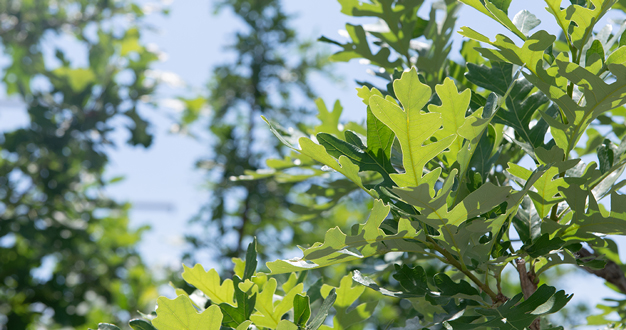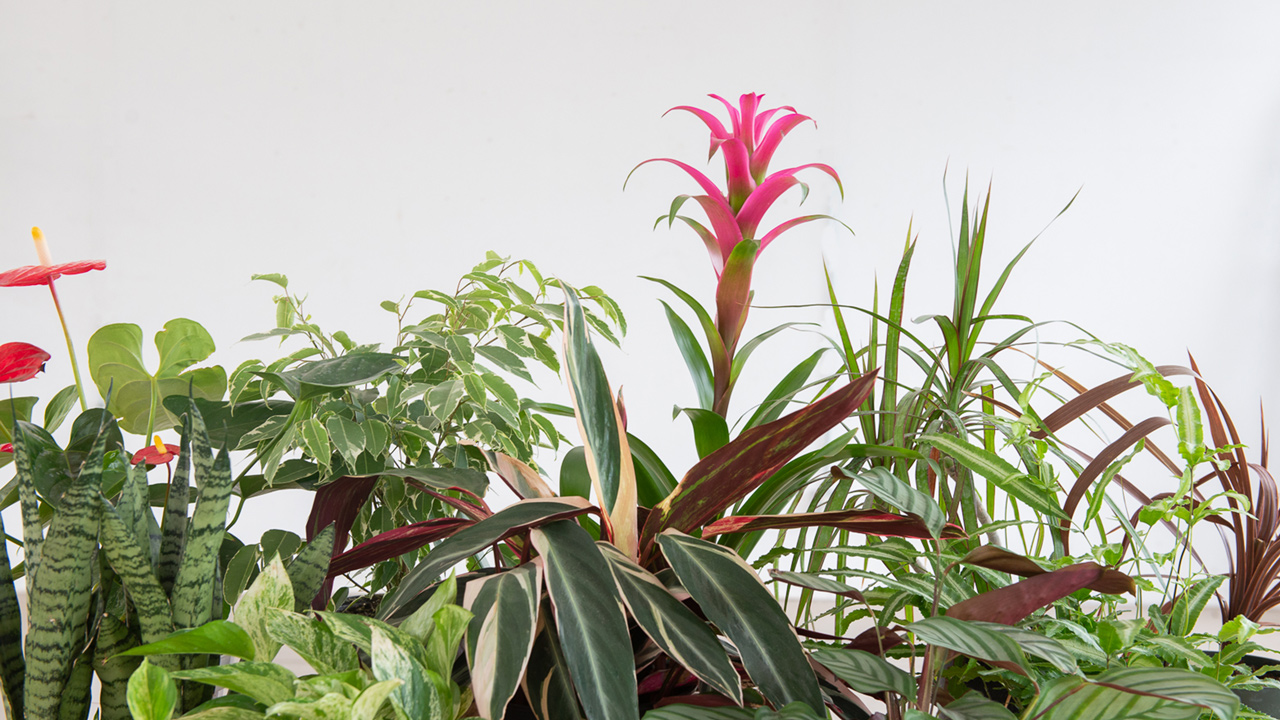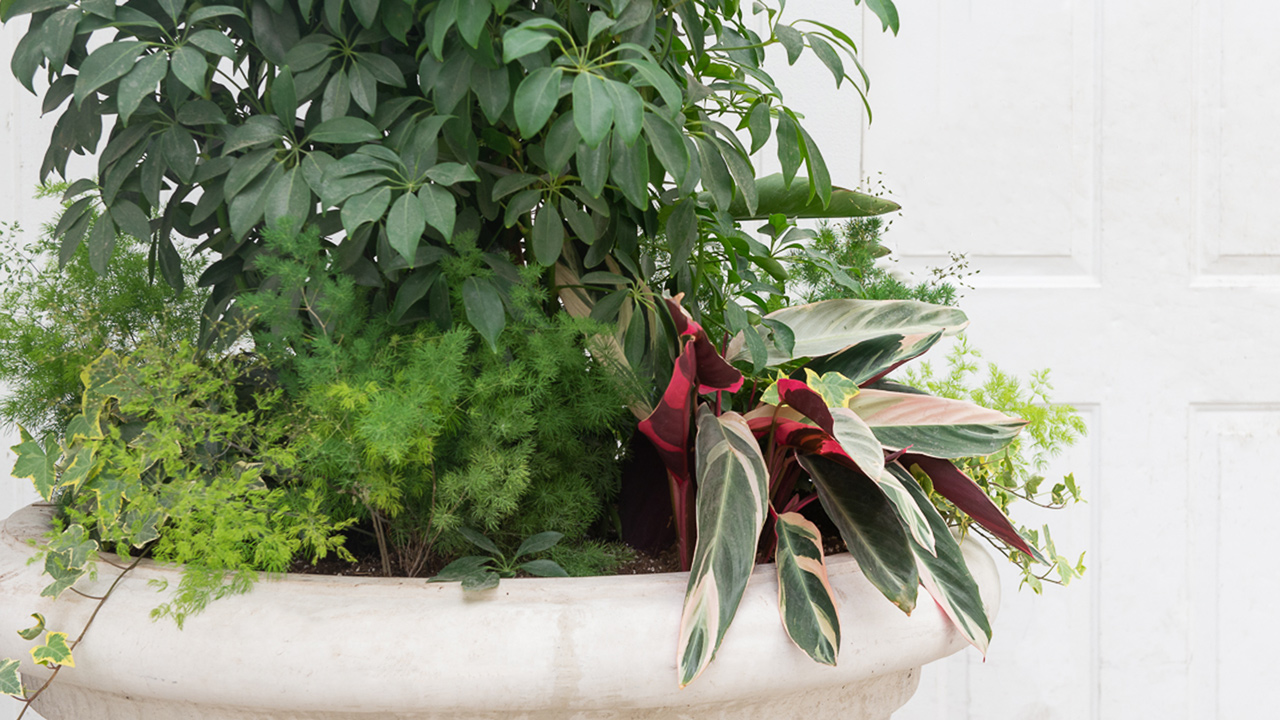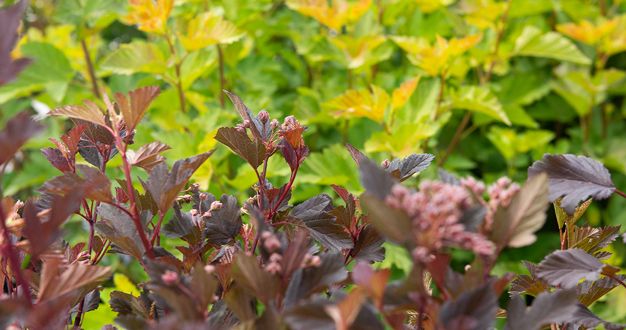
As plant parents, we love filling our indoor spaces with greenery, but did you know houseplants can be beautiful elements in outdoor container arrangements too? It’s true. And using houseplants in your outdoor containers has some definite benefits to both you and the plants. Here we look at a few reasons not to ignore houseplants when designing your next outdoor container. And we share our best tips to make your houseplant arrangement a gorgeous and successful one.

Beauty In the Shade + In the House
Using houseplants in outdoor container arrangements has its benefits. In shaded spaces, keeping blooming flowers going can be a challenge, but brightly colored or patterned tropical plants – like dracaena, cordyline, sansevieria, calathea, pothos, bromeliad, and anthurium – keep their color and texture all season long. Foliage with white and silver-tones almost glow in low light too – look for white variegation or silver hues in some varieties of pothos, fern, ivy, and ficus.
And although houseplants enjoy the heat and humidity of summer, they aren’t done when the season is over. Unlike most flowering annuals, these plants can come inside and continue providing beauty to your home even after the cold weather arrives.

Tips for Outdoor Arrangements
Planting an outdoor container arrangement with houseplants is similar in many ways to planting a container with annuals – but with a couple differences.
Potting Mixes + Pots
Houseplants enjoy the same well-draining professional potting mix in their outdoor containers as they do indoors. Our favorite potting mix for indoors and out is Fafard Professional Potting Mix. Be sure your outdoor pot has a good drain hole and that it’s the right size to accommodate the number and size of the plants you’re using.
Design
Outdoor arrangements look their best when they’re made up of plants with different heights – center, supporting, and trailing – plus a mix of textures. In the large pots at the entrance to the Greenhouse, our Container Garden team has created a dynamic mix with smooth bird of paradise, fuzzy ming fern, finger-like pteris fern, tall green schefflera, trailing variegated ivy, and colorful ‘Tricolor’ stromanthe.
Care
Even in the shade, the light outdoors is a lot brighter for your plants than they typically find indoors. That plus higher temperatures and summer breezes will cause your houseplants to drink more water than they do inside the house. Just like with indoor plants, water your outdoor houseplants when the top portion of soil becomes dry – but keep a close eye. The soil dries faster outdoors, and your plant may need a drink much more often than you’re used to. And a dose of fertilizer from time to time will keep them healthy and growing all season too.

When It’s Time to Come In
Outside, when the plants in your outdoor arrangement are enjoying all the bright light, fresh air, and warm temperatures, a group of all different kinds can live happily together in the same pot. But, inside is a different story. Under indoor conditions, the individual personalities of the plants become apparent, and it becomes more difficult to find a light level, temperature, or watering schedule that pleases everyone.
So when it’s time to come inside in the fall, we recommend repotting your plants into individual pots. Then every plant can find the perfect light it needs, get the water it wants, and nobody has to compromise – sometimes to their detriment. To make this process easier, it’s a good idea to plan ahead as you’re first putting the arrangement together in the spring. We recommend keeping large plants in their grow-pots and “planting” the pot into the soil in the outdoor container. Then in the fall, you can just pull the grow-pot out, clean it off, and you’ll be ready to head inside. Plants that prefer to be root-bound – like sansevieria – appreciate this method too.
Design with Houseplants
Next time you’re putting together a shade container for an outdoor space, consider using a few asparagus fern, pothos, or dracaena along with your impatiens, coleus, and begonias. Or you can make your design a mix made entirely of tropical houseplants too. Not sure how to begin? Just ask our team in the Greenhouse. We love thinking up new ways to use houseplants, and we’re happy to offer new ideas and tips anytime.


